Low Blood Sugar (Hypoglycemia)
If hypoglycemia isn’t treated in time, it can lead to loss of consciousness, seizures, or other serious consequences. That’s why a quick and effective response is so important.
This content is not medical advice. Always consult your endocrinologist, doctor or diabetes care team before making any changes to your diabetes treatment or daily management.
What Is Low Blood Sugar (Hypoglycemia)?
Hypoglycemia, or low blood sugar, is a condition where the level of glucose in the blood drops below normal, usually below 3.9 mmol/L (70 mg/dL). For people with type 1 diabetes, it’s one of the most common and urgent complications and can develop suddenly, even without warning signs.
Low blood sugar occurs when there is more insulin in the body than glucose, meaning the body doesn’t have enough fuel to function properly. The brain, which relies heavily on glucose for energy, is especially affected which is why early symptoms often include confusion, shakiness, dizziness, or mood changes.
Mild hypoglycemia can be corrected quickly, but if left untreated, it may lead to loss of consciousness, seizures, or even coma.
Causes of hypoglycemia
Eating too few carbohydrates at a meal or snack
Meals with insufficient carbs may not match the insulin dose given.Skipping or delaying a meal that includes carbohydrates
Especially dangerous if insulin has already been administered.Physical activity without extra carbohydrate intake
Exercise burns glucose. Without extra food, especially during longer or more intense activity, blood sugar can drop significantly.Unplanned or prolonged physical activity
Activities like walking, playing, or running around for longer than usual without a snack can also lead to lows.Taking insulin or glucose-lowering medications at the wrong time
A shift in the timing of medication (especially fast-acting insulin) may lead to mismatches with food.Too much insulin or oral glucose-lowering medication
Even a slightly higher dose than needed can cause hypoglycemia.
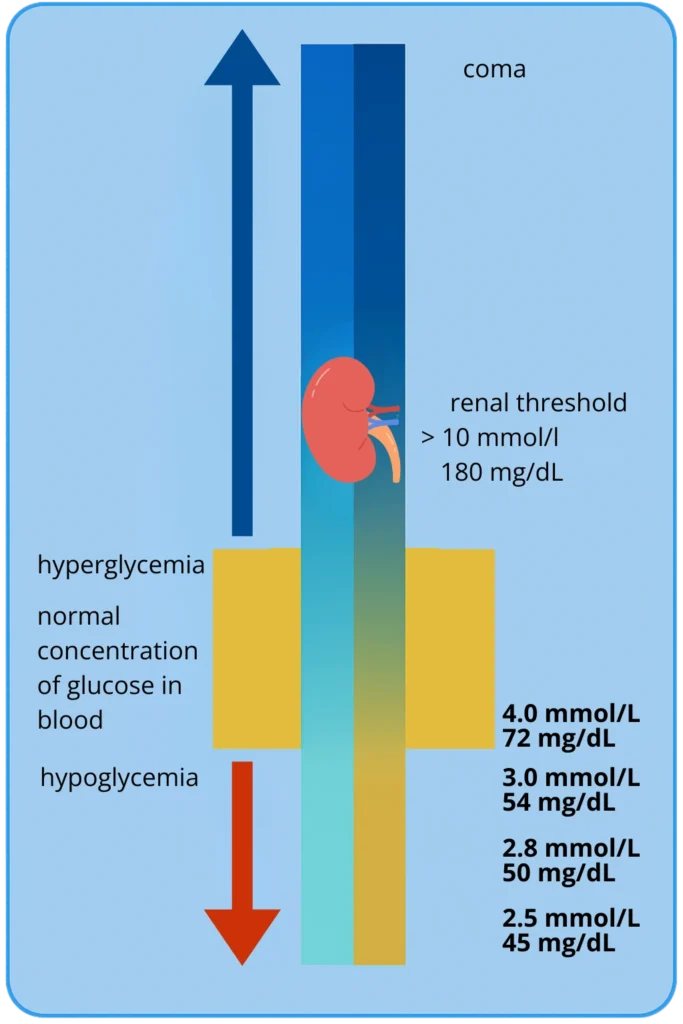
Hypoglycemia during sleep can go unnoticed and may result in waking up tired, confused, or with a headache.
Using a CGM with alarms can help detect and prevent overnight lows, especially in people who are prone to frequent drops in blood sugar.
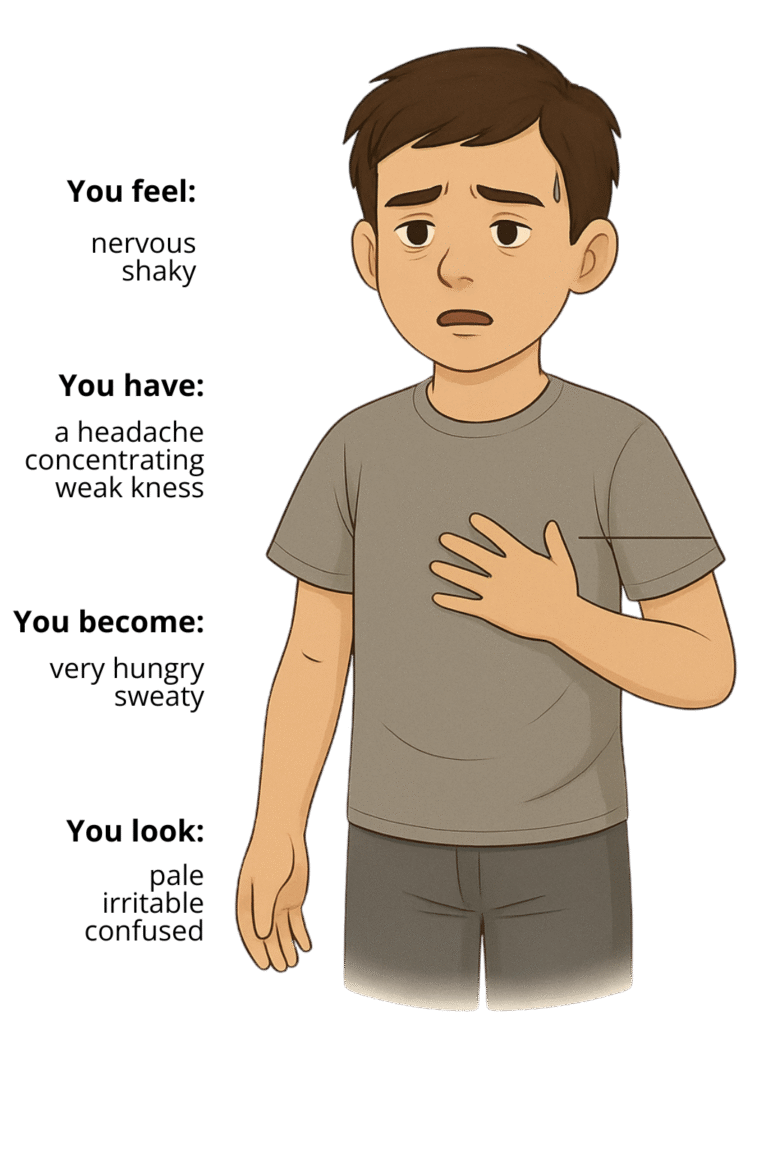
Signs and Symptoms of Hypoglycemia
Hypoglycemia can come on suddenly and worsen quickly. Symptoms vary from person to person. Some may notice mild warning signs, while others may experience severe symptoms without much warning.
Common signs of low blood sugar:
Inability to think clearly / confusion
Shakiness
Sweating and cold skin
Restlessness or anxiety
Blurred vision / spots in front of the eyes
Irritability or a general feeling of unease
Numbness in the lips or tongue
Slurred or difficult speech
Rapid heartbeat (palpitations)
Headache
Sudden weakness or fatigue
Severe hypoglycemia (emergency symptoms):
If hypoglycemia is not treated in time, it can lead to:
Confusion or disorientation
Loss of coordination or collapse
Loss of consciousness
Seizures (convulsions)
Coma
Severe hypoglycemia can happen quickly and without warning. Always carry fast-acting carbs like glucose tablets or juice, and let others know how to help you in an emergency.
How to Respond to Low Blood Sugar?
Mild Hypoglycemia
Symptoms:
Irritability, shakiness, sweating, rapid heartbeat, pale or clammy skin, dizziness, yawning.
Treatment:
Follow the Rule of 15: consume 15 grams of fast-acting carbohydrates such as fruit juice, glucose tablets, or sugar. Wait 15 minutes, then recheck your blood glucose level. If it’s still low, repeat the treatment. If your next meal is more than 30 minutes away, eat an additional snack that contains both carbohydrates and protein (e.g., crackers with cheese or a glass of milk). For younger children, the carbohydrate amount should be adjusted based on age and body weight.
Moderate Hypoglycemia
Symptoms:
Confusion, poor coordination, difficulty cooperating or communicating, slow or slurred speech.
Treatment:
If the person is able to swallow safely, apply glucose gel or cake decorating gel inside the cheek, between the gum and cheek. Squeeze out the appropriate amount. If there’s no improvement after 15 minutes, administer glucagon. If the next meal is not soon, provide an extra snack that includes carbohydrates and protein to help stabilize blood sugar levels.
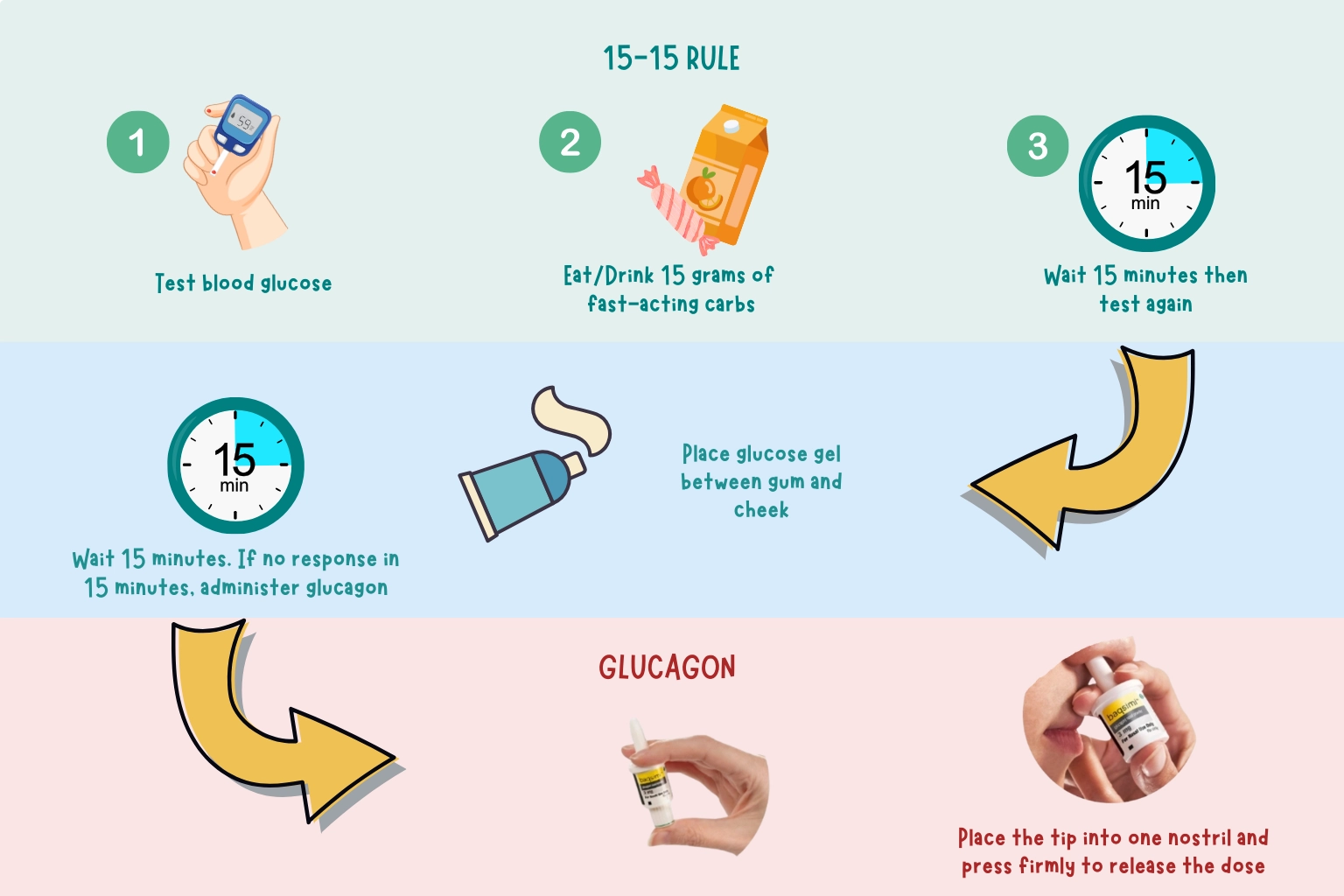
What to Do If Someone Is Unconscious Due to Severe Hypoglycemia?
1. Do NOT give anything by mouth
Never attempt to give food, drink, or glucose orally — this can lead to choking.
2. Check the person’s airway
Gently open the mouth and check if the tongue is blocking the airway. If needed, adjust the head slightly to ensure airflow.
3. Turn the person onto their side (recovery position)
This prevents choking in case of vomiting and helps keep the airway clear.
4. Administer glucagon immediately
Use a ready to use glucagon like GVOKE, BAQSIMI or ZEGALOGUE. Follow the specific instructions (nasal spray or injection).
5. Call emergency services right away
Dial the local emergency number for immediate assistance.
6. Stay with the person and monitor breathing
Remain nearby. If the person regains consciousness, only offer food once they are fully awake and able to swallow safely.
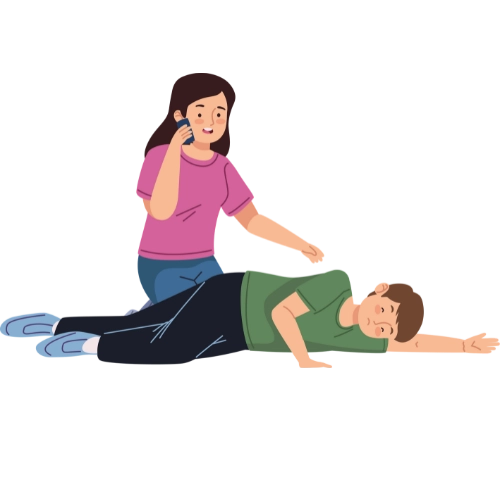
Never give food or drink to someone who is unconscious — it can cause choking. Use glucagon immediately and wait for the person to regain consciousness.
Advanced insulin pumps can automatically adjust insulin delivery based on CGM data, helping to reduce the risk of hypoglycemia, especially during the night or physical activity.
Learn when and how to use glucagon in case of severe low blood sugar.
Join as a T1D Warrior
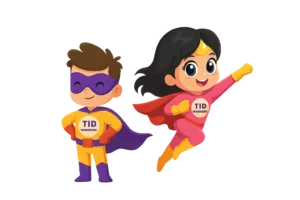
Our T1D Warriors are children, parents of children with diabetes, and individuals living with type 1 diabetes who share their personal experiences to inspire and support others. Every story, every blog post, and every piece of advice you find here comes from someone who has truly lived it — with honesty, courage and a whole lot of heart. Together, we’re building a community where real-life experience truly makes a difference.
Want to inspire others with your T1D journey? Become a T1D Warrior and share your story.
